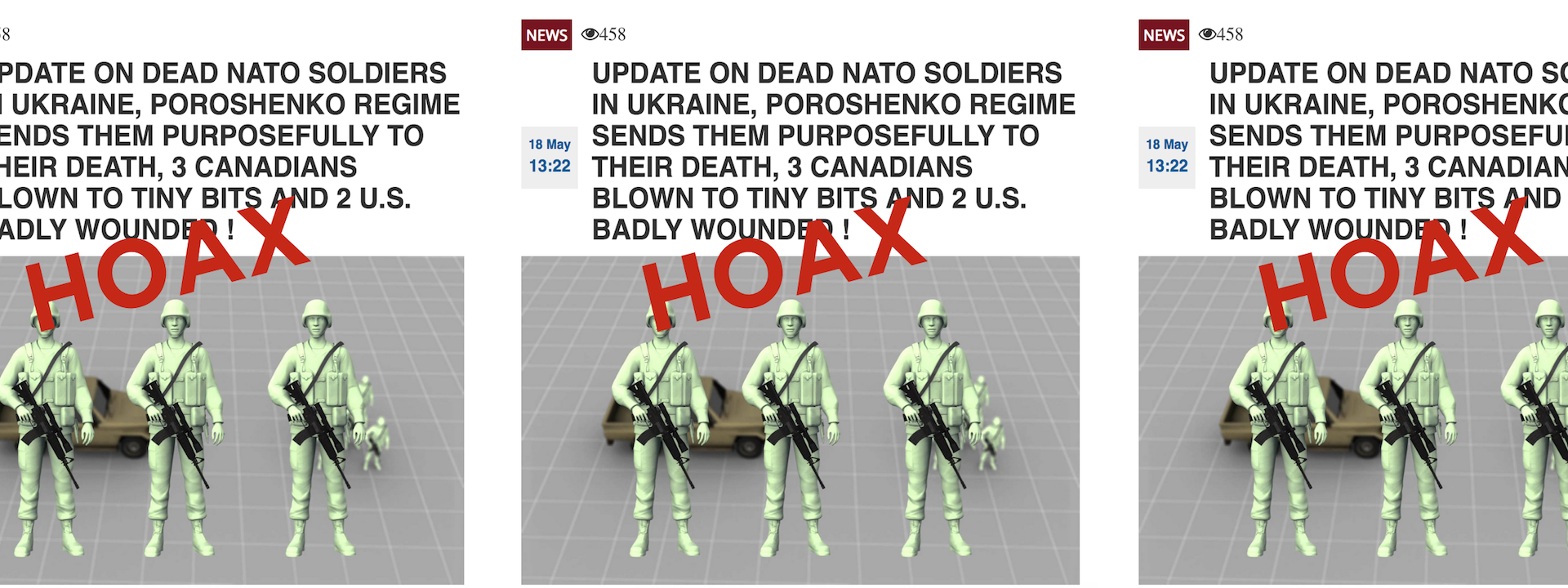#PutinAtWar: NATO Soldiers Not Killed in Eastern Ukraine
How a network of Kremlin-funded media outlets spread a hoax about three dead Canadian soldiers in Ukraine
#PutinAtWar: NATO Soldiers Not Killed in Eastern Ukraine

How a network of Kremlin-funded media outlets spread a hoax about three dead Canadian soldiers in Ukraine

On May 17, little known Donetsk News Agency published an article claiming that three NATO servicemen from Canada were killed and another two from the United States were wounded after their vehicle struck a landmine near the Ukrainian town of Avdiivka, on the frontlines of the war in eastern Ukraine. This would have been a tragic incident, were it not for the fact it was completely fictitious.
The Story
The false headline read:
A car carrying NATO servicemen exploded after hitting a landmine near Avdiivka, three dead — DNR’s reconnaissance

@DFRLab contacted U.S. Army Europe for a comment and received a response saying “the story is inaccurate” and “all Joint Multinational Training Group — Ukraine soldiers are accounted for”. Separately, the Canadian Department of National Defence and the Canadian Armed Forces told CTV News Canada that the claims circulating in the Russian media were false, and no Canadians were killed or injured.
Given the lack of evidence presented in the initial story, proving or disproving the incident directly presented a challenge. So we went to the subject of the reporting, which provided evidence on the contrary. Not an ideal verification mechanism, but measurably more accurate than the initial false reporting.
The Spread
Despite the story being a hoax, as one basic step of fact-checking revealed, the claim spread widely with Kremlin-funded and pro-Kremlin media.
Out of fifteen Russian news sites that published the story between May 17 and May 18, at least five were directly funded by the Kremlin — TASS News, RT, Sputnik, RIA Novosti, and Zvezda TV.

Apart from being funded by the Kremlin, these news outlets are some of the most influential in Russia.
All articles that spread the hoax explicitly blamed the Ukrainian Armed Forces for the death of the three soldiers. One report said, “The command of the Ukrainian Armed Forces led the guests to a minefield, where the car carrying foreigners exploded.” The goal of this disinformation campaign was clear — to sow discord between Ukrainian armed forces and its partners at NATO and suggest that NATO servicemen were active on the front lines.
The story spread far beyond the Russian borders. In English language, the hoax was spread by known conspiratorial and pro-Kremlin websites, including the pro-Kremlin Free West Media, pro-Kremlin NRT24, conspiratorial Conspiracy-cafe, pro-Kremlin SouthFront, and StalkerZone.
Spread on Social Media
The story spread moderately on social media, where the hoax was shared over 4,000 times, predominantly on Facebook.

On Twitter, the story was shared by known pro-Kremlin accounts, among whom was @MauriceSchleepe, whose bio read, “News from the East,#Novorossia,#Russia and the Middle East.Stop #NATO.”
Breaking a Car with Military instructors from #NATO countries blew up on a Minefield near #Avdeevka,the Command of the #Ukraine regime forces led the Guests #NATO troops to A Minefield,three NATO troops from #Canada killed and two #US forces wounded. pic.twitter.com/jpBfm08wbT
— Maurice Schleepen (@MauriceSchleepe) May 17, 2018
The most popular tweet sharing the hoax was posted by @Vityzeva, who is a News Front contributor. News Front is a pro-Kremlin news outlet and, according to a whistle-blower interviewed by Die Zeit, is funded by Russian intelligence. @Vityzeva’s tweet garnered 681 retweets and 792 likes at the time of this report.
В Донбассе на линии соприкосновения подорвались инструкторы НАТО. Погибло трое военнослужащих из Канады и два военных США. Инцидент произошел на минном поле, выставленном ВСУ. Как натовский джип занесло на заминированную территорию – пока остается загадкой.
— Юлия Витязева (@Vityzeva) May 17, 2018
Conclusion
This story was an example of disinformation laundering, whereby a false story was first published by a small news site in eastern Ukraine and then picked up by Russian state-funded media outlets and pro-Kremlin websites. @DFRLab documented a similar case back in January 2017, when a false report of NATO sending 3,600 tanks to the border with Russia, initially published by a small news outlet in Eastern Ukraine, and then picked up by large Kremlin-funded media outlets and American fringe media. Both cases showed that a false story can spread as far as the agendas and biases of its sharers will allow.
Follow along for more in-depth analysis from our #DigitalSherlocks.

